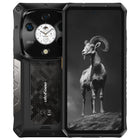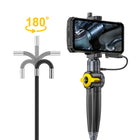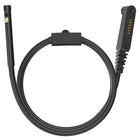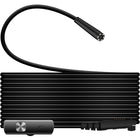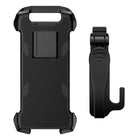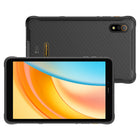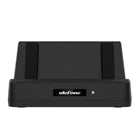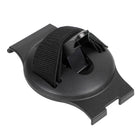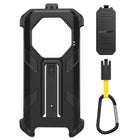Thermal Camera Applications Building
Building Thermal Camera Applications
The versatility and abilities of thermal cameras allows building surveyors to carry out a huge amount of different types of building analysis efficiently and with no damage to the immediate environment, beating other types of meter such as moisture meters which require damaging materials slightly to gain measurements.
Building Surveys
Using thermal cameras in building surveys isn’t really a new thing. It’s been going on for decades now, but it’s only until recently that the technology has become affordable enough for many to adopt the units as part of their building surveillance equipment.
In order to understand the use of a thermal camera in building analysis, you first need to understand how the devices work. The main principle driving the technology behind a thermal imager is IR, or infrared. This is part of the light spectrum, but is completely invisible to human eyes normally.
IR radiation exists all around us on a daily basis. It’s given off by literally everything around us, from the lights overhead to our very own bodies. Even the desks in our offices or our mundane objects in the home all give off some form of IR radiation. A thermal camera is able to pick up on this ‘emissivity’ of IR radiation and converts the IR light into a visible image that showcases the detected heat differences as different colours on the image.
This allows users to tell at a glance that something may be too hot or too cold. In the case of building work, it could be used to showcase that an LED light fitting is outputting far too much heat, or alternatively it could be used to detect cracks in the walls or ceiling that might be letting in cold draughts. The thermal camera’s popularity in this sector is certainly justifiable, as many of the things a camera will detect would most likely go completely unnoticed if the imager wasn’t used.
The versatility of IR cameras in this sector, combined with innovations in the technology which have reduced the price of owning a unit, have resulted in a boom in these devices being adopted in the building sector.
In order to accommodate for this change many manufacturers – particularly FLIR – have started developing thermal imaging systems built specifically for use in building applications. A comprehensive building survey completed using a camera like this is much more efficient and professional than using other tools, helping the user save time, money and effort on carrying out extensive testing procedures. It’s also of benefit to the person getting a thermal building survey completed, as the thermal camera will spot things that any other tester would simply fail to detect.
Thermal Cameras in the Home
Building analysis is regularly carried out in domestic properties to evaluate the overall integrity of the building’s structure and/or to analyse the energy output of the property being evaluated.
Thermal cameras are again being adopted more and more in this field, and they’re a great tool for detecting a lot of problems in the home from both the outside and the inside.
One of the more obscure uses for thermal cameras in the home (well, technically outside the home) is police using the systems to spot extremely hot houses. More times than not massive spikes in the heat of a house means the person inside is using high powered heat lamps to grow drugs; many a time drug dealers have been caught because a thermal imaging system mounted on a helicopter spotted the excessive heat output coming from a house.
A normal building surveyor might use a thermal camera in a similar fashion, but this will be with both feet firmly on the ground. By scanning outside a property with a thermal imaging system the user can spot hot and cold spots in the exterior brickwork of the property, detecting problems that may be caused by moisture, cracks in the building materials or more complex damage via insects or plants.
Solar Panels & Thermal Cameras
Building thermal cameras are beginning to be used commonly in the growing solar market. With recent changes coming in to the UK relating to the Green Deal (the government’s new scheme to install renewable, sustainable energy sources in properties) the introduction of solar panels on residential properties is becoming increasingly more commonplace.
The efficiency of a solar panel in an installation is the most importance aspect of the unit. Since it is designed to work with renewable energy (in this case, sunlight) and convert it into energy via the use of a complex photovoltaic installation, an incorrectly installed solar system can be the difference between saving a significant amount of money and wasting money on a system that isn’t working.
By evaluating the solar panel installation (including solar modules) with a thermal imaging camera it is easily possible to spot mysterious hot spots forming on modules or the solar panels themselves. This generally means there is something wrong with the system and action can be taken before these problems develop further and reduce the efficiency of the solar PV system.
More information on solar panels and thermal cameras:
Renewable Wind Energy
Another form of popular renewable energy that’s increasingly growing is harnessing the power of wind.
You’ve no doubt seen wind turbines dotting the horizon around the UK, turning our blustery weather into energy we can use to power everything we use on a daily basis. Thermal cameras can play a part in maintaining the efficiency of these turbines as taking thermal images of the turbine allows users to spot spikes in thermal emissivity, which may again be a precursor to problematic installations.
Internal damage to components inside a wind turbine isn’t just annoying for the engineer who has to repair it – it can also be life threatening. Breakdowns in rotors, gearboxes and brakes inside the turbine can cause it to rotate too quickly and – in the worst case scenario – this could cause the giant rotor on the outside of the turbine to detach and fall to ground.
A thermal camera would spot problems in these essential components long before they become a problem.
Comprehensive Building Diagnostics
We've touched upon it briefly before, but what exactly are the benefits of using a thermal camera in building diagnostics?
Insulation Evaluation
One of the most common uses of building thermal cameras is detecting breakdowns in insulation inside our outside of a property. Incorrectly installed insulation can have an effect on both the persons inside the property and the overall energy efficiency of a building, leading to those living/working in the area feeling cold and more money being spent on heating the building when all it is doing is leaking outside rather than staying inside the area.
A thermal camera is able to detect draughts and breakdowns in building insulation by monitoring the temperature of the environment. If cold spots are present in areas that should otherwise be hot this generally means heat is somehow escaping from the environment; the thermal camera is able to pick up on the changes in heat distribution in the area and the person using the camera can then investigate further to find problems with the insulation.
Moisture Detection
Moisture can have an extremely damaging effect on buildings and quite often it can go undetected for significant periods of time. Leaking pipes, water getting in from outside and other factors can cause moisture build-up in the walls, floor or ceilings of a property and it is only when the water starts to show itself as a damp spot or mould growing in areas it shouldn't be that many people become aware of the presence of moisture.
Moisture content in a property can be evaluated using a tool such as a moisture meter, but this would require testing multiple spots around the area and could also involve causing damage to materials due to the need to use moisture pins to measure the water content under the surface or the properties' structure. In comparison a thermal imaging camera requires no invasive testing in order to operate; it simply scans the environment and moisture content can easily be spotted in the structure by detecting colder spots that simply shouldn't be there.
HVAC Efficiency
Heating Ventilation Air Conditioning (HVAC) requires the use of constant system efficiency in order to maintain correct heat levels. Breakdown in internal components or incorrectly installed HVAC systems can cause the system to put out excessive levels of air, no air at all or even put out extremely cold or extremely hot temperatures. In environments where a comfortable level of heating and ventilation must be maintained at all times, correctly installed HVAC systems are completely essential.
In a story from FLIR about a hospital using HVAC systems and a thermal imaging camera, they state:
"The camera provides us with the right information and allows us to make well based decisions with regard to maintenance of the HVAC system and troubleshooting all kinds of building issues", says one of the hospital technicians. "The air temperature in the hospital should be 22°C and the air coming from ventilation ducts should be 18°C. There are thermometers installed in certain parts of the building and these provide feedback for the automated HVAC system we use. This gives us a general overview, but if we want more specific information about the airflows and temperature distribution in a room we need the FLIR thermal imaging camera."
"From time to time complaints might arise from patients about a room being too hot or too cold", he adds. "With the thermal imaging camera we can quickly assess whether there is actually something wrong in that room. If nothing is wrong, the screen of the thermal imaging camera allows us to immediately show the patient that the temperatures are perfectly normal in the thermal image. And if there is a fault the FLIR thermal imaging camera helps us to find the problem much faster, allowing a quick repair."
Temperature and airflow distribution in an area such as a hospital - where people may be sick and ventilating diseases may be catastrophic - is extremely important to be maintained at all times. Other applications such as HVAC systems installed in offices or properties aren't as important for strict maintenance procedures, but a thermal imaging system deployed in these areas can also help to improve the overall environment so that humans can work comfortably at all times.
FLIR cameras make youngsters enthusiastic about technology
60 FLIR i3 cameras delivered to middle-level vocational schools (VMBO) throughout the Netherlands for project work around building inspections.
It goes without saying that technical education in the Netherlands can use a helping hand every now and then. That’s exactly the reason why the government regularly takes initiatives to generate interest for technology with young people. Through an initiative of the Dutch fund for training and development for the technicalinstallation sector (Opleidings- en ontwikkelingsfonds voor het Technisch InstallatieBedrijf - OTIB), thermal imaging cameras from FLIR Systems have been made available to students of middle-level technical and vocational schools (so called VMBO schools).
In twelve schools across the Netherlands, VMBO students are working with FLIR thermal imaging cameras. By means of a FLIR i3 camera, these students are performing building inspections, on the lookout for cold bridges, missing insulation materials, moisture, etc. In addition, the middle-level VMBO students are accompanied by younger students from elementary schools to form project groups. This way, OTIB is hoping to stimulate interest for technology with students both from the elementary and middle-level schools.
In 2012, a pilot project was rolled out in the Markland College in Oudenbosch, the Netherlands. “This project found its origin in ‘3X3 wordt 10’ ('3X3 is 10'), a range of courses on sustainability and energy conservation which was offered in our school," said John Stoop, team leader at Markland College.
"3X3 wordt 10 offered children the opportunity to understand what energy is, to become aware of the importance of energy, but also to see how much energy is wasted every day. All this insight was offered through experimentation with a thermal imager."
Because of the success of the pilot project, it was decided to expand it into twelve schools throughout the Netherlands. “The project actually serves two purposes," says John Stoop. "On the one hand, this is a sustainability project, in which we want to make our students aware of the importance of isolating your own home. On the other hand, these thermal imaging cameras really generate interest for technology among young people. We have noticed that students are really enthusiastic when they can work with these cameras.”
Technical installation sector
OTIB is the training and development fund of the Dutch technical installation sector. Representing some 10,000 employers and more than 125,000 employees, the fund provides the industry with support in order to further develop knowledge and skills. OTIB also aims at making young and old more acquainted with technology. To be true to this mission, OTIB devotes considerable attention to a sound and attractive vocational education and to the promotion of the intake of students.
FLIR cameras across the Netherlands
Through KWx, a Dutch FLIR distributor and specialist in the field of test and measurement instruments, 60 FLIR i3 cameras were delivered to OTIB. In turn, this organization made sure that the FLIR cameras were distributed to schools across several regions in the Netherlands.
“The FLIR i3 camera is a very ergonomic and user-friendly camera, which makes it very suitable for VMBO and elementary students to get acquainted with this technology,” comments Kees Compaan at KWx. “We are very glad that in this way, KWx has the opportunity to contribute a little to the promotion of technological education in the Netherlands.”
"For their building inspections, the students are provided with a thermal imaging camera and a visual camera," says John Stoop. "This way, they can compare both images and see exactly where the insulation problems are."
Thermal imaging technology for building inspections
Thermal imaging technology increasingly finds its way in the installation sector, because it is able to quickly and accurately trace problems that are invisible for the human eye or for other measurement equipment. Today, a thermal imaging camera looks just like a regular compact digital video camera, and it is equally easy to use. For many professionals, the sharp thermal images have become indispensable to detect energy losses in buildings. Energy efficiency is high on the agenda in many countries, which will cause a higher demand for thermal imaging cameras. A big advantage of thermal imaging cameras is that it is not necessary to break into the surface to investigate or to detect a problem.
The FLIR i3 is the smallest, lightest and most affordable thermal imaging camera on the market. It is incredibly easy to use and requires no former experience. It really is a matter of "point-shoot-detect" to obtain high-quality thermal images that will immediately give the user the thermal information he or she needs.
“What we liked the most about the FLIR i3 is the user-friendliness of the camera,” comments John Stoop. “The FLIR i3 is very easy to operate, everything is self-explanatory. Moreover, the camera can be easily connected to a PC or laptop, so you can easily transfer images and share them with others.”
Carlill Energy uses FLIR i7 thermal imaging cameras to detect problems with Solar Power Plants in Punjab, India
When solar energy panels threaten to fail, defects will usually generate heat. Luckily for Carlill Energy, because the company has successfully adopted the use of thermal imaging cameras to detect and identify problems with photovoltaic (PV) cells, junction boxes and grid network connections in a very early stage.
Punjab, India, is endowed with a vast potential of solar energy with over 300 days of sunshine in a year. Carlill Energy Private Limited is a frontrunner in the development of solar power plants in the state of Punjab, India. Across the state, the company has already installed a solar plant capacity of 1.5 MW. The latest plant has been commissioned in February 2012 in Muktsar (Eastern Punjab), in conformance with the Punjab Energy Development Agency (PEDA) directives. The plant has a very high PR value among the many different solar power plants in the state of Punjab.
Early detection and inspection of diode boxes
After having an issue with a failed diode box in the recent past, Carlill Energy started to look out for a solution that was able to provide an advance warning. Based on such a warning, the company was hoping to be able to take precautionary measures and prevent incidents with failed diode boxes from happening again. After thorough research of the marketplace and based on feedback from industry professionals, it was decided to go for a FLIR thermal imaging camera. FLIR’s distributor M/s Industrial Agencies, based in Chandigarh, India, provided Carlill Energy with a FLIR i7 thermal camera.
M/s Industrial Agencies also took care of training of the Carlill Energy maintenance staff. During the training, three major hot spots in junction boxes were observed. According to the maintenance staff, the failure of these connections could have hampered the plant’s power generation as well as the company’s PR.
Strong performance, wide range of applications
The management team of M/s Carlill Energy was enthusiastic about the performance of the FLIR i7 camera: “We should have bought this equipment last year when we were actually commissioning this plant.” Today, the company uses three FLIR i7 cameras. Next to the identification of issues with diode boxes, Carlill Energy is also using the FLIR i7 thermal imaging camera for the identification of issues with PV cells and the grid network connections/terminations.
According to Mr. Satnam Singh, Maintenance Manager at Carlill Energy, the FLIR i7 thermal imager will help him identify problematic areas and, as a result, ensure flawless supply of electricity to the grid. In addition, this will increase the overall return on investment of the company for this plant.
FLIR i7 thermal imaging camera
The FLIR i7 is the smallest, lightest and most affordable thermal imaging camera on the market. It is incredibly easy to use and requires no former experience. It really is a matter of "point-shoot-detect" to obtain high-quality thermal images that will immediately give the user the thermal information he needs. The camera is extremely easy to understand and operate, and has been designed for entry-level users.
The FLIR i7 produces instant, point-and-shoot JPEG thermal imagery that carries all required temperature data and can be stored internally or externally, sent and analyzed. The unit only weighs 365 g, and is easy to store in a belt pouch. FLIR i-Series thermal imaging cameras withstand a 2 meter drop. They are watersplash proof and IP43 rated.
Reporting and analysis software included
Carlill Energy also opted for the FLIR Tools software, which has been designed to quickly import, edit and analyze images, and turn them into convincing, professional PDF inspection reports, ready to print or email, so users can get a “yes for repairs” fast.
*Products with Thermal Imaging:
Armor 27T pro,Armor 25T Pro,Armor 25T, Power Armor 18T Ultra, Power Armor 19T, Power Armor 18T, Armor 11T 5G, Armor 9.

